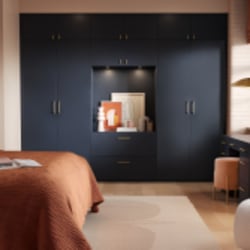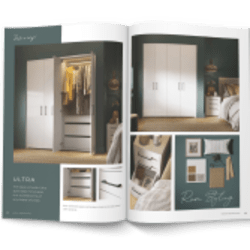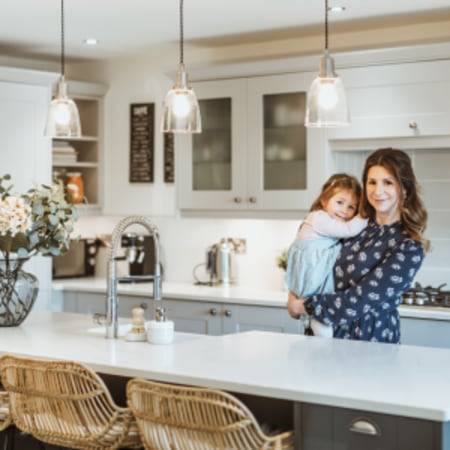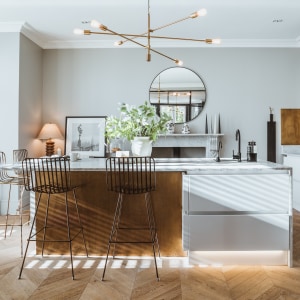Kitchen Worktops: Buying Guide
Kitchen Worktops
When beginning any kitchen refurbishment, there are numerous kitchen parts and appliances you need to think about before you can even begin making purchases. Your oven, dishwasher, cabinets - everything needs to be carefully considered so you can nail your preferred aesthetic and bring your dream kitchen to life. This makes picking your kitchen worktops a crucial step in the kitchen building process.
Kitchen worktops are the centrepiece of any kitchen, influencing your style choice for every other fitting you’ll be buying. Therefore, your work surfaces should be one of the first things you settled on for your new kitchen plan. They’re the first thing people see upon stepping into the room and have the capacity to bring warmth and life to a potentially dull location.
However, there are many different types of kitchen worktops available. It can be a little daunting as you begin to sift through the various materials on offer. After all, not all types of kitchen worktops will suit a contemporary or traditional kitchen, and you need to be sure they’ll work seamlessly with your choice of kitchen cabinets. But such an essential part of kitchen refurbishment shouldn’t be intimidating, which is why we’ve created this easy to read worktop buying guide, so you can buy your kitchen worktops safe in the knowledge they’re the right fit for you.

Before you start
Before you settle on one of the various types of kitchen worktops available, there are a number of things you should consider that will affect your purchase. Material choice, colour and finish, kitchen size, and budget all need to be accounted for to ensure you buy kitchen worktops suitable for your space.
With such a large surface area to cover, worktops can be expensive by nature, meaning they’re going to be a part of your kitchen for a decade or longer unless you have the money to replace them outright. This makes it crucial to get your choice right the first time. By garnering a thorough understanding of what goes into choosing a kitchen worktop, you can be sure you’ll buy worktops to suit your kitchen perfectly.
Check your measurements
Like with so many kitchen appliances and fittings, it is absolutely essential that you carry out appropriate measurements of your kitchen space. This means selecting the areas where you intend your kitchen cabinets to sit and measuring the length and width of those spaces. These measurements need to be as accurate as possible to ensure a comfortable and smooth fit for your countertops.
Ideally, these measurements should match up to your chosen kitchen cabinets, but you should increase the width slightly to allow for an overhang. Remember to account for the shape of your cabinets. If there are corners, consider these when measuring, as well as cut-outs for sinks, hobs, and taps. Knowing how thick you want your worksurfaces to be is also useful as thicker material will cost more.
Once you have your measurements ready, multiply the length and width of each section together in meters to find the total square meter area (sqm) of your worktops. This is important to know as most types of countertops are sold by sqm.
This process can seem time-consuming. Fortunately, you can pay a professional kitchen fitter to make the measurements for you, ensuring they’re as accurate as possible and advising you on exactly how many separate worktop pieces you might need. If you’re really not sure where to start when it comes to measuring up, book a free, no-obligation home measure from a Wren kitchen expert, and we can have a qualified surveyor measure your kitchen and worktops for you.
Ask for samples
Knowing what material you want your worktops to be made out of is just as important as measuring the space needed to fit them. Different types of kitchen worktops lend themselves better to particular kitchen aesthetics. Wood might look good in a traditional kitchen, whereas granite and quartz have much more of a contemporary feel.
You should have an idea of what style you want your kitchen to be before you buy worktops, making it easier to narrow down which material you should pick. The best way to get an idea of how these materials will look is with samples.
All good kitchen retailers will be able to provide you with large samples that you can place in your kitchen. It’s much easier to visualise and pick the best material for your kitchen worktops when you can physically see the material in front of you.
Consider your budget
Finally, you need to work out your budget. The cost of your chosen worktops is going to be heavily influenced by the material you buy, as well as its thickness and quality. Worktops can be expensive, but you should pick the material that’s right for your home that suits your day-to-day use in the kitchen.
Again, think about kitchen aesthetic and what materials fit with your style. This will narrow down your material choices, and when combined with your measurements, will give you an average cost of required materials. This will allow you to budget appropriately.
It’s also important to remember potential installation costs if you’re not fitting the kitchen yourself. These will vary so be sure to ask your chosen kitchen fitter for a quote.

Countertop materials
There are many different types of kitchen worktops available. The most common materials available consist of wood and laminate options, but if you’re feeling luxurious, then a natural stone like granite can lend an air of opulence to the room.
However, not all types of worktops are as durable or easy to clean as others. If you do a lot of food prep and hob cooking, you’ll want a material that’s both resilient and simple to clean. You should also consider the required maintenance each material requires and whether you are prepared to carry it out. Consider the pros and cons of each material against what you’re looking for and buy countertops accordingly.
Laminate
Cost-effective and versatile, laminate countertops are capable of mimicking a variety of other worktop materials but at a greatly reduced cost. Laminate worktops are constructed by binding a plastic overlay to a wood board and coating it to simulate the desired surface.
This allows laminate to come in a range of styles and colours not feasible with other materials, and combined with their antibacterial and wipe clean qualities, laminate can be a durable but inexpensive option.
However, the relative cheapness of laminate means that you need to be wary of the quality of material you purchase. Bad quality laminate scratches easily, and once this happens it can’t be repaired. Laminate is also susceptible to peeling, burning, and melting when exposed to very high heat, meaning you should be careful about what you place on countertops made from laminate. If particularly long-lasting worksurfaces are what you’re after, then you should look at luxury laminate - and if you want something intensely durable then consider a harder-wearing countertop material like granite or timber.
Granite
Granite is one of the most extravagant types of kitchen worktops available. Stylish and beautiful, granite is hard-wearing, heat resistant, and antibacterial. It’s also very easy to clean, requiring only warm water and a microfibre cloth or a granite spray. And as for maintenance, granite worktops only need to be resealed every few years.
The downside of all these benefits though is that granite can be incredibly heavy and expensive, and, despite granite’s durability, it’s still capable of being scratched. You should avoid cleaning granite with abrasive cleaners and sponges. Any scratches on your granite worktop can be buffed or sanded down, but their initial purchase expense means it might not be worth buying them if you find your current worktops are being scratched regularly.
Timber
Timber countertops offer a more homely and rustic feel but can work well with almost any kitchen style; their wide variety of natural grains and colours also means you can still find a unique style that’ll suit your aesthetic, and most wood continues to look great as it ages. Timber countertops are a natural fit for Shaker style kitchens, or for any kind of traditional kitchen in soft and neutral tones.
Wood is much cheaper than natural stone, though the price will fluctuate depending on your chosen wood. If you want a traditional feel, then wood such as oak or walnut is a great choice. For a more exotic touch, you could try Africa teak.
Be aware though that wood can both scratch and stain with little effort, and if exposed to water, you should wipe it clean immediately. Wood surfaces also need sealing at least twice a year to maintain integrity.
Corian
Corian is rather unique when it comes to kitchen worktops. Made from a blend of natural materials pressed and bonded together with an incredibly strong resin, Corian can be easily moulded to fit most kitchen shapes while being an entirely seamless single piece that runs around your worksurface area. Corian has the added properties of being heat, scratch, and stain-resistant, as well as being very easy to clean.
Naturally, this does make Corian more expensive than wood or laminate, and while granite and quartz are tougher, Corian offers a nice middle ground between resilience and price.
One very important thing to note about Corian is that, while it’s waterproof, if damage to the resin allows water to seep in, it will cause substantial damage that can be hard to repair.
Quartz
Another man-made alternative to natural stone, quartz is similar to Corian, being fortified with a resin for maximum durability. Quartz is one the hardest wearing types of worktops out there, coming in a vast range of colour options and being simple to keep clean. In many ways, quartz is superior to granite. It has antibacterial properties but is also naturally resistant to nearly all scratches and stains.
Quartz is a very low maintenance worktop option, but this low maintenance comes at a price. Quartz is heavy and one of, if not the most expensive type of worktop material out there.

Countertop edges
Choosing between the types of countertops available is not just about material. The edge and thickness of your countertop can be just as important to aesthetics as what they’re made out of.
Eased edges
Eased edges are the classic type of countertop edge, being geometrically enticing and looking good in most kitchens thanks to their smoothed corners. These help to soften the environment around them. Eased edges look especially great with quartz.
Bullnose edges
Bullnose edges take the safety properties of eased edges and smooth off the edged angles for a rounded finish. This is the classic style for soft and sophisticated kitchens. Bullnose edges are a good option if you have young children and particularly thick counters.
Bevelled edges
If you want an uncommon edge type, you might want to look into bevelled edges. A bevelled edge is cut at a slopping 45-degree angle, helping to reduce chipping and increasing resistance to wear and tear. Again, this makes your countertop look less sharp. Bevelled edges are classy and don’t cost much more than other edge options.
Ogee edges
Ogee edges can be compared to a bulging wave in shape. This traditional style uses concave and convex arches to curve the edge out in a pleasantly rounded shape. Ogee edges are one of the more expensive edge options, but they really add character to your kitchen.
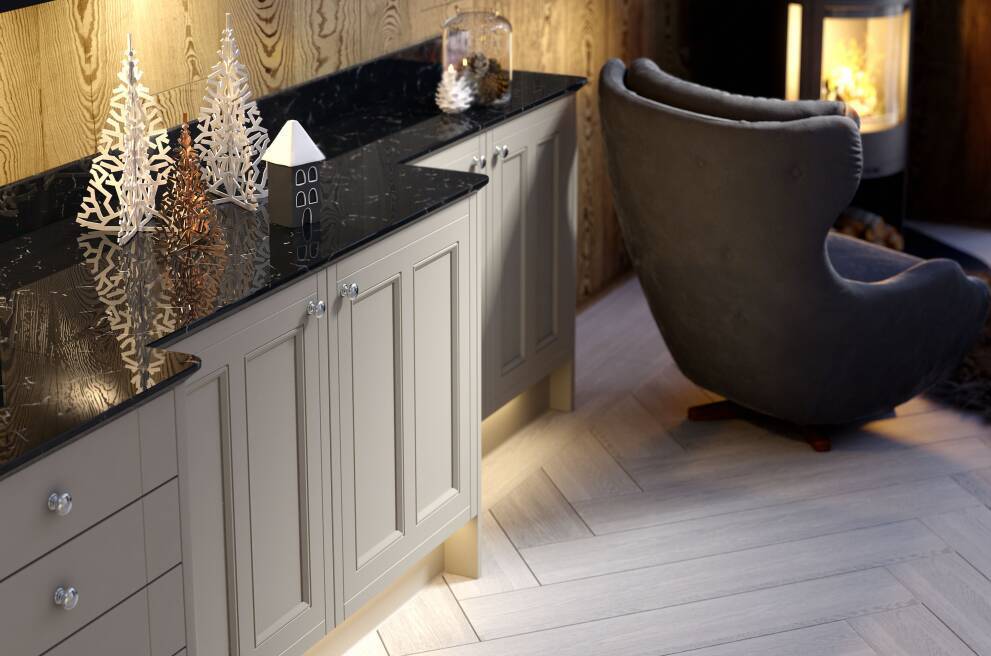
Worktop finishes and colours
While plenty of types of countertops come with their own standard finish, it’s still possible to add a personal finish or colour to your chosen material to really make it your own.
For colours, there are three common choices. White is a good option for brightening up areas. It meshes well with neutral styles and helps your kitchen to appear more open, making it ideal for compact or dark spaces. Black, on the other hand, helps to emphasise bold tones while minimising marks that appear in your worktops. Lastly, grey is good for a pastel colour palette or to soften bold hues, making it very customizable.
As for finishes, gloss puts a substantial shine on your worktops and helps to enhance an already impressive material. Its reflectiveness can make small areas feel more open and inviting. Alternatively, a matt finish is entirely sheen free, softening dark tones while making marks less obvious for easier maintenance. You can also go for a textured finish if you choose laminate worktops. Wood and stone work well for natural texture replication, providing a premium look for less while being smooth, organic-looking, and easy to clean.
Where to buy kitchen worktops
All good kitchen retailers are ideal places to buy kitchen worktops, typically having a wide range of material and edge options available to choose from. Here at Wren Kitchens, we can provide all the material options mentioned in this guide and help you install them, meaning you’ll have no trouble designing your perfect kitchen. For more information on how to care for your kitchen worktops, you can read our guide right here.
With Wren Kitchens, our team of appliance experts have decades of experience in helping you pick and choose the ideal worktops for your kitchen. Book your appointment at your local showroom today to speak to an expert and we’ll guide you through the process of building your dream kitchen.
If you want to fit your kitchen out even further, we have a range of appliances such as coffee machines and microwaves that will look great on any worktop. Why not take a look at our other kitchen and appliance buying guides or check out our inspiration section for more great ideas?








